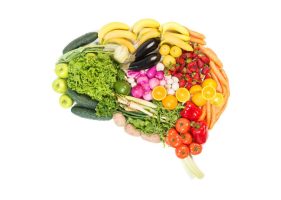BDNF stands for Brain-Derived Neurotropic Factor
Brain-derived neurotrophic factor, BDNF, is a neurotrophin. Neurotrophins are important for the survival, repair and growth of neurons. Neurons are nerve cells that process, transmit or process information in the brain or nervous system. Neurons can be thought of as the data cables between parts of the brain and the body. An average body has about 100,000,000,000 neurons (100 billion).
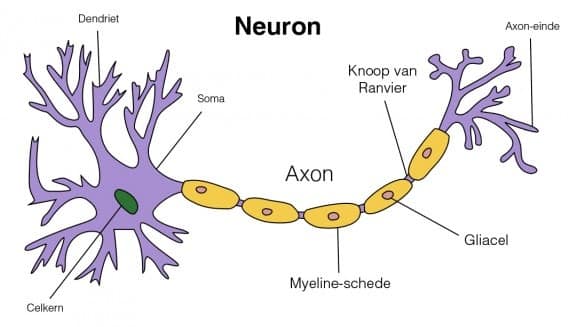
Too little BDNF
A lack of neurotrophins such as BDNF contributes to the development of neurodegenerative diseases. The lack of BDNF ensures that neurons cannot recover from damage. This can cause Alzheimer's, Parkinson's and/or Huntington's disease to develop. Furthermore, depression can arise when too little BDNF is present for a longer period of time. The degeneration of neurons in the frontal lobe of the brain appears to be the culprit. Too low serotonin levels also contribute to depression. The depression is worsened because a low serotonin level ensures that not enough BDNF is released via the 5HT2A receptor (see also the image below and bear in mind that the 5-HT receptor is not stimulated or is only stimulated to a small extent).
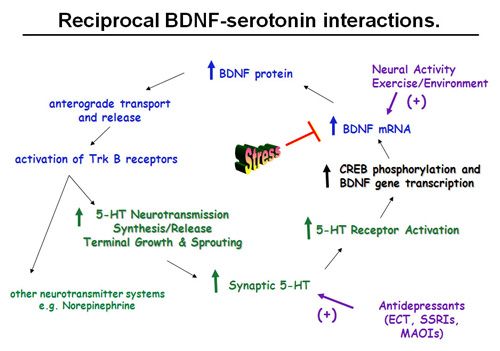
More BDNF
You can produce more BDNF by stimulating the 5HT receptor. When the body releases more BDNF, it flips the switch on a series of genes that grow brand new brain cells and nerve cell connections. Even slightly higher BDNF ensures that you learn faster, remember better, age more slowly and your brain quickly rearranges the connections with the different parts of the brain and body.
BDNF also increases the plasticity of your brain. When your brain cells become damaged or encounter a stressful situation, BDNF protects them and helps them come back stronger. The neural pathways become more flexible rather than broken down, which could explain why higher levels of BDNF are associated with warding off depression.
With a few changes in daily habits, the brain can be adjusted to release more and more BDNF, making the brain more resilient and stronger in the face of any adversities that come with life.
BDNF and serotonin
More serotonin therefore ensures an increased release of BDNF via the 5HT2A receptor. When we look at how we can stimulate the serotonin receptor more, we have to look at how we can increase serotonin and how we can keep the receptor sensitive to stimulation.
Also check out our previous post about increase serotonin for more tips
Nutrition and lower BDNF
The foods below are known to provoke inflammatory responses and lower serotonin, which also lowers BDNF.
Sugar: Eating sugar, especially fructose, directly inhibits BDNF production and causes cognitive decline. Fructose together with glucose in a molecule is what we call table sugar. Avoid added sugar as much as possible. Sugar also causes inflammatory reactions in the body, causing less serotonin to be released.
Bad fats: Bad fats cause inflammatory reactions in the body, which reduces the release of serotonin through inflammatory factors. The bad fats are usually vegetable omega 6 fats used for frying such as sunflower, soy and peanut oil. Hydrogenated (vegetable) fats are also bad fats.
Dairy: Dairy can also have a pro-inflammatory effect when consumed at high levels. It is best not to consume sweetened or unacidified dairy products. Unsweetened kefir or yogurt can therefore be eaten in moderation.
Gluten: Eat as few grain-based products as possible. Gluten can also cause inflammation, especially in allergic reactions. Oats and therefore oatmeal can be eaten.
Alcohol: Alcohol is fermented sugar and is best avoided entirely. If alcohol is consumed, half to a full glass of wine per day can be drunk without too much damage. Above that, alcohol already becomes an inflammation promoter.
Meat: Game, grass-fed meat and wild fish are no problem provided that red meat is eaten in limited quantities (recommended maximum twice a week). Any fish that is not wild caught or fed differently than natural should not be eaten. Grain- and corn-fed animal products are also discouraged.
Nutrition and higher BDNF
All anti-inflammatory foods and nutrients indirectly help to increase BDNF. All antioxidants, polyphenols and omega 3 therefore increase BDNF. The building blocks of serotonin must of course also be included in the diet. Below is the BDNF increasing diet.
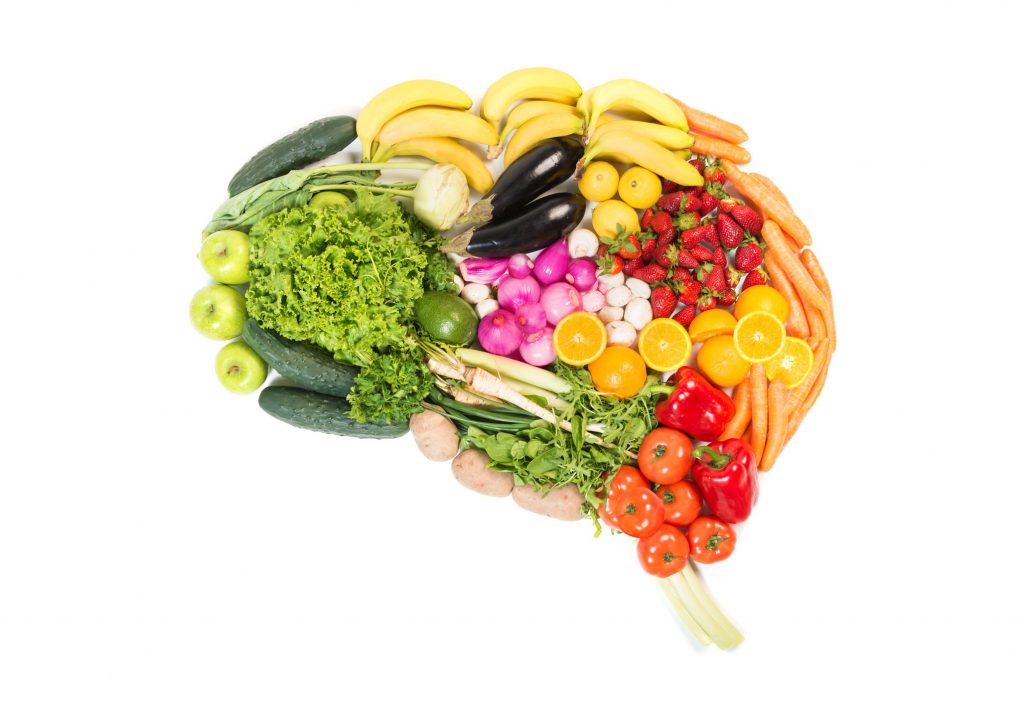
Complex carbohydrates: Complex carbohydrates are slowly digestible and ensure stable blood sugar levels, which means less insulin is needed. This prevents insulin insensitivity and thus various inflammatory reactions in the body. Most sources of complex carbohydrates also contain many antioxidants and dietary fiber. It is advisable to consume vegetables for half of all food, with 2 pieces of fruit per day and a little oats. A handful of nuts per day can also have a positive effect on serotonin production.
Omega-3: Omega 3 fatty acids DHA and EPA play an important role around the serotonin receptor. For example, EPA is an important anti-inflammatory agent and DHA makes the cell membrane of the 5HT receptor more sensitive to serotonin. DHA and EPA rich foods are fish, crustaceans and shellfish. Algae and krill also contain a lot of EPA and DHA and the human body can also make them from the Omega 3 fatty acid ALA, which is commonly found in linseed oil and walnut oil.
Omega-6: Where we consume omega 6 in abundance and we actually have to limit our intake, GLA (gammalinolenic acid), an omega 6 fatty acid, can help us against inflammation. The body can only produce this rare omega-6 fatty acid to a limited extent. Supplementation can be done with Borage oil (Borogo Officinales), Middle evening primrose oil (Oenothera Biennis) or Black currant seed oil (Ribis Nigrem).
Polyphenols and antioxidants: Antioxidants and polyphenols in particular work very well against the oxidation of body molecules because they can absorb free radicals such as free oxygen. This prevents the body from inflammation due to oxidation (such as iron can rust). Almost all natural plant foods are full of polyphenols and antioxidants. The better a food protects against free radicals, the higher the ORAC value, which stands for Oxygen Radical Absorbance Capacity.
View a list of here ORAC values
Tryptophan-rich diet: Tryptophan is the precursor of 5-HTP and serotonin and must therefore be obtained through food. Foods high in tryptophan include oatmeal, nuts, seeds, spirulina, cocoa (pure), sesame seeds, chickpeas, spinach, sunflower seeds, parsley, asparagus, mushrooms, broccoli, beans, nuts, seeds, soy beans and turkey.
Vitamin B: Vitamin B3, B6 and B12 are additives in the formation of serotonin. Food that can provide the B vitamins is (grass-fed) meat, fish, (acidified) dairy, whole grains, vegetables, fruit, potatoes, legumes, eggs, and (cashew) nuts. A vegan should supplement with B12 because B12 only occurs in animal foods.
Minerals: Minerals such as zinc, iron and magnesium play an important role in many biochemical processes in the body, including the formation of serotonin. Eat as much vegetables as possible and if you cook vegetables, cook them for as short a time as possible. Combine with as many vegetables as you can manage. Vary with nuts such as cashews, pistachios, walnuts and pecans. Cocoa is very rich in minerals in its pure, unprocessed form. Whole grains such as brown rice and oats (malt) are also good sources of minerals.
MAO inhibiting foods: MAO is an enzyme that breaks down serotonin, among other things. This is a natural process that is supposed to take place. However, certain foods can be used to inhibit MAO activity in a healthy way and in moderation so that serotonin is not broken down as quickly. Seaweed, turmeric, passion flower and rhodiola are mild MAO inhibitors.
Supplements and BDNF
We previously wrote about supplements that can increase serotonin and therefore also BDNF. If diet is not enough, you can also supplement.
View here serotonin boosting supplements
Intestinal flora and BDNF
The right nutrients are needed to produce BDNF via serotonin. In the intestines it is the bacteria that pre-digest many of the important substances for you. Without pre-digestion we cannot obtain all the substances that the body needs. So first of all, make sure that you have the right bacteria in your intestines by taking a probiotic that contains one or more of the following strains: Lactobacillus acidophilus, Lactobacillus casei and Bifidobacterium bifidum. Then you give those bacteria and yourself the right nutrition and dietary fiber from mainly vegetables, legumes, moderate fruit and some whole grain products such as oatmeal.
Exercise and BDNF
Cardio training produces a protein called FNDC5 (ibronectin type III domain-containing protein 5). FNDC5 in turn increases BDNF by 200-300%. The increase is long-term. In a study with men who cycled daily for 3 months, BDNF levels almost quadrupled.
Regular strength training also increases BDNF, but this only lasts for just a few minutes after training. A better form of training is interval training or any other form of sport that alternates between high intensity and rest.
Sleep and BDNF
Deep sleep causes a release of DMT, which is similar to serotonin and therefore also activates the 5HT2a receptor. This causes the body to release BDNF during the deeper stages of sleep. There are four stages of sleep that repeat every 90 minutes. On average, you spend about a third to half a night in phases 3 and 4. During this phase, the activity of DMT and BDNF is at its highest.
Meditation and BDNF
Meditation reduces stress and therefore increases BDNF. A good and deep meditation ensures that the body “thinks” that it is sleeping and releases DMT. DMT causes more BDNF to be released by stimulating the 5HT2a receptor. The same applies to breathing techniques that make the body appear as if it is asleep.
Sunlight and BDNF
Sun exposure increases BDNF by increasing vitamin D. It also improves mood, and actually reduces your risk of skin cancer, provided you don't burn yourself. Go outside in direct sunlight for fifteen minutes a day. Unfortunately, in winter the sun is not strong enough. Supplementing with vitamin D or eating oily fish, liver, cheese (least choice) or egg yolk can help you get vitamin D in the winter.
Social contact and BDNF
Lack of meaningful mental stimulation leads to lower BDNF levels. Social isolation also contributes to depression, which decreases BDNF. Reduce social media use and make contact in real life. BDNF is very good at conversing with strangers and gives you a good feeling afterwards.
Psychedelics and BDNF
Psychedelics increase BDNF production and neurogenesis. This explains why there have been so many studies coming out lately about psychedelic-assisted therapy helping with depression and PTSD.
The highest possible stimulation of the 5HT2a receptor to release BDNF is the use of psychedelics. So these are really mind-altering drugs (English for medication). Psilocin from magic mushrooms, DMT from ayahuasca or LSD stimulates the 5HT2a receptor in such a way that BDNF also increases considerably. This combination causes neurogenesis, which means the creation of new neurons, at an unprecedented level.
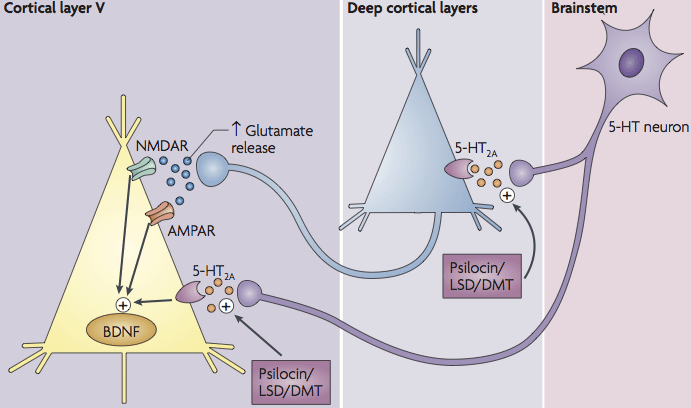
Our trip therapy and BDNF
We use psilocybin-containing mushrooms or magic truffles in our trip therapy. After conversion in the body to psilocin, psilocybin provides a very high stimulation of the 5HT-2a receptor. This stimulation and the release of BDNF due to the stimulation of the 5HT2a receptor causes the brain to enter a state of hyperconnectivity (see image).
During this state of hyperconnectivity, neurogenesis takes place and the conscious brain connects with the subconscious. This allows problems in the subconscious to be resolved, resulting in less stress, which actually slows down BDNF. New permanent connections are also made and repair work takes place to remedy the damage of depression. Even neurodegenerative diseases can be combated by the activity of BDNF, because new neurons and therefore connections are created.
Support from us
It is clear that psilocybin is a very powerful and natural medicine against neurodegenerative diseases and depression. High stimulation by psilocybin is called tripping and hallucinations can occur at higher doses. For the elaboration of this trip, it is highly advisable to hire a professional "trip sitter" or therapist. See who is available via the button.
References used:
https://www.ncbi.nlm.nih.gov/pmc/articles/PMC3022308/
http://onlinelibrary.wiley.com/doi/10.1113/expphysiol.2009.048512/full
http://www.sciencedirect.com/science/article/pii/S2095254614001161
https://www.ncbi.nlm.nih.gov/pubmed/27385735
http://journals.plos.org/plosone/article?id=10.1371/journal.pone.0076050
https://www.ncbi.nlm.nih.gov/pubmed/25584253
http://www.nature.com/nrn/journal/v16/n4/full/nrn3916.html
https://www.ncbi.nlm.nih.gov/pubmed/24705269
https://www.ncbi.nlm.nih.gov/pmc/articles/PMC4104707/
https://www.ncbi.nlm.nih.gov/pubmed/23727882
http://www.nature.com/nrn/journal/v11/n9/fig_tab/nrn2884_F1.html
https://www.jstage.jst.go.jp/article/jphs/91/4/91_4_267/_article
https://www.ncbi.nlm.nih.gov/pmc/articles/PMC4104707/
https://www.ncbi.nlm.nih.gov/pubmed/23312069
http://file.scirp.org/pdf/FNS_2013083011411606.pdf
http://www.jneurosci.org/content/30/38/12653
https://www.ncbi.nlm.nih.gov/pmc/articles/PMC3977651/
https://www.ncbi.nlm.nih.gov/pmc/articles/PMC3487856/
https://academic.oup.com/jnci/article/97/3/161/2544132/Sunlight-and-Reduced-Risk-of-Cancer-Is-The-Real
http://journals.plos.org/plosone/article?id=10.1371/journal.pone.0076050
https://www.ncbi.nlm.nih.gov/pubmed/25584253
https://www.ncbi.nlm.nih.gov/pmc/articles/PMC2694409/
https://www.ncbi.nlm.nih.gov/pmc/articles/PMC3448146/
https://www.ncbi.nlm.nih.gov/pubmed/11119686
https://www.ncbi.nlm.nih.gov/pubmed/16533499
